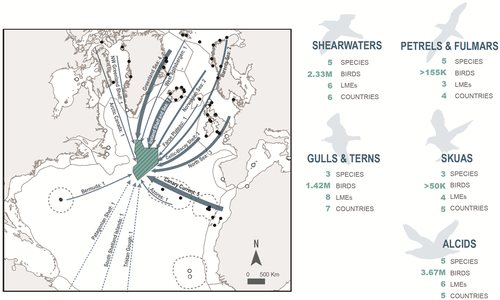After years of focused campaigning, and backed by state-of-the-art scientific evidence, a new marine protected area (MPA) has been designated in the North Atlantic Ocean.

The North Atlantic Current and Evlanov Sea marine protected area – or NACES MPA – was designated by the 15 countries (and the EU) that are signatories to the OSPAR Convention, during OSPAR’s decadal Ministerial Meeting in October 2021. The MPA covers nearly 600,000 km2 of the High Seas (the part of ocean that’s beyond any national jurisdiction) and protects an area that is vitally important for seabirds.
Seabird tracking data, compiled by BirdLife International on its Seabird Tracking Database, showed how the area acts as a magnet for hungry seabirds, as millions of them, representing 21 species, converge on the highly productive area during their migratory cycle to feed and socialise. Such an observation would have been impossible without the advances in live tracking technology and the infrastructure to store and analyse tracking data. GOBI continues to support BridLife International in this endeavour.

Seabirds in the area feed at depth on fish, squid and crustaceans whose own presence and abundance is influenced by the deep ocean and seafloor, as well as other oceanographic variables. By feeding on such prey and migrating across the globe to breed and nest (and be eaten), seabirds form an integral link in the chain of interconnected events that contribute to a healthy functioning ecosystem, connecting the deep seafloor mid-ocean to the coastlines of the Atlantic margin. Protecting seabirds, their foraging areas and habitat, is a significant step in the preservation of a multitude of other processes important for, and dependent on, biodiversity as a whole.
Following designation, a management plan will be devised that takes into consideration maritime activities that pose a potential threat to seabirds and the ecosystem they form part of. Such threats include bycatch, overfishing, energy production, mining, climate change and pollution. Protection will involve the prohibition, reduction or mitigation of certain threatening activities, to ensure current and future uses don’t compromise the biodiversity and ecosystem processes supported by the area.
Despite a concerted effort to have the seafloor included in the designation of the NACES MPA, political differences between OSPAR signatory States prevented its inclusion at this stage. However, a two-year period has been allocated to collect and review additional data on conservation features with the aim to expand the conservation objectives of the MPA.
The NACES MPA designation lends strength to the formal identification by Parties to the CBD of the Mid-North-Atlantic Frontal System candidate EBSA, described during the most recent regional EBSA workshop in the northeast Atlantic Ocean (Stockholm, September 2019). This candidate EBSA, alongside 16 others described at that workshop, await formal identification at CBD COP15, whose ability to meet has been hampered by the Covid-19 pandemic. The rescheduled CBD COP15 is due to take place in early 2022. The EBSA description reaffirms the area’s importance not just for seabirds, but also for whales, sea-turtles, tunas and sharks (several of which are globally threatened), all of which confirms that this is an area of high productivity, with a high intensity of foraging activity, and with productivity cascading to all trophic levels.


